- Django Interview Questions
- Python Array Examples
- Python enum
- Python Enumerate with Example
- Python Flask Tutorial For Beginners
- Python For Beginners - Way To Success
- Python For Data Science Tutorial For Beginners
- Python for loop
- Python GET and POST Requests
- Python IDEs for Python Programmers
- Python Interview Questions
- Python Lists with Examples
- Python Partial Function Using Functools
- Python Print
- How to generate random numbers in python
- Python Regular Expression (RegEx) Cheatsheet
- Python Sleep Method
- Python List Methods
- Python Split Method with Example
- Python String Functions
- Python Tutorial
- Python Variable Types
- Python vs Java
- Python vs SAS vs R
- Python Operators
- Code Introspection in Python
- Comprehensions in Python
- Python Exception Handling
- Defining Functions - Python
- Generators & Iterators in python
- Install Python on Windows and Linux
- Introduction to Python Programming
- Lists concepts in Python
- Loops in Python
- Regular Expression Operations in Python
- Python Serialization
- String Formatting - Python
- R vs Python: Which is better R or Python?
- Six Digit Salary With Python
- Top 20 Python Frameworks List
- Why Learn Python
- Python Substring
- OOPs Interview Questions
- Career Shift To Python : Success Guaranteed
- Face Recognition with Python
- Go vs Python
- Pyspark Interview Questions
- Python Pandas Interview Questions
- OpenCV Interview Questions
- Python Project Ideas
- Flask Interview Questions and Answers
- Array Interview Questions
- What is PyCharm?
- What is Seaborn in Python?
- What is Anaconda Navigator
- Numpy Broadcasting - Detailed Explanation
- Python Data Science Interview Questions
- Genpact Interview Questions
- Python Developer Job Description
- Pandas Projects and Use Cases
- DataFrame Tutorial
- How to install Python on Windows
- Pyspark DataFrame
Capgemini Technical Interview Questions
Capgemini Python Interview Questions
Capgemini SQL Interview Questions
Capgemini Automation Testing Interview Questions
Capgemini Testing Interview Questions
Capgemini Power BI Interview Questions
Capgemini Leadership Principles
Capgemini is one of the leading consulting and technology firms in the world, with a strong presence in numerous industries, including financial services, healthcare, and retail. With such a broad range of offerings, it's no surprise that Capgemini is a top destination for job seekers. In fact, the company currently employs over 270,000 people worldwide and has been recognized as one of the world's most ethical companies by the Ethisphere Institute.
If you're feeling overwhelmed by the prospect of a job interview at Capgemini, don't worry. With a bit of preparation, you can feel confident and poised when answering even the toughest questions. Try practicing these common interview questions, and reviewing the job description to ensure you have a good understanding of the position's requirements. By following these tips, you'll be well on your way to acing your Capgemini interview and securing your dream job.
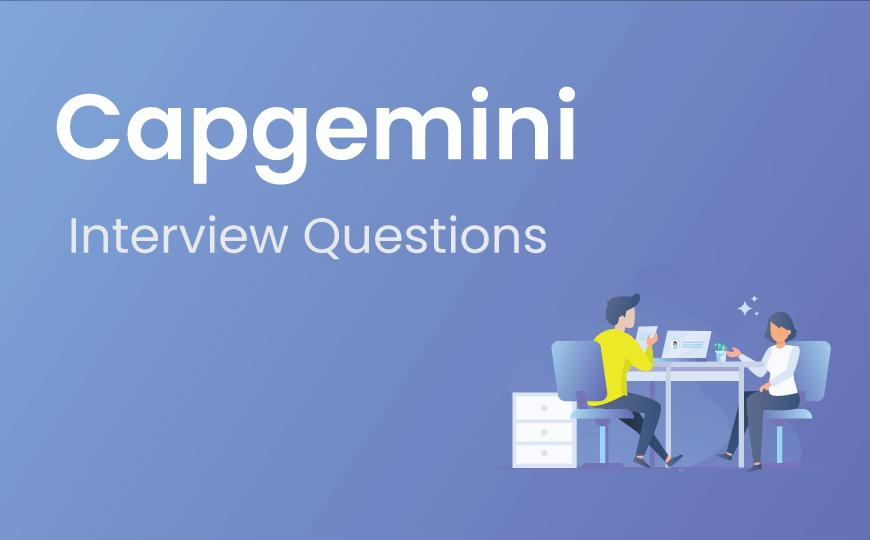
- Interview Process
- Capgemini Technical Interview Questions
- Leadership Principles
- Tips
- FAQs
- Conclusion
Top 10 Frequently Asked Capgemini Interview Questions
- List the Advantages of Python.
- Why do we use the Django Framework?
- What do you mean by SQL?
- How is DBMS different from RDBMS?
- What do you mean by Automated Testing?
- What do you mean by Browser Automation?
- Briefly describe Agile Testing
- Differentiate verification and validation.
- What is Power BI, and why do we use it?
- Distinguish power BI, power query, and power pivot.
Capgemini Interview Process

Preparing for an interview can be daunting, but with the right approach and mindset, you can ace it here is a Comprehensive Guide to the Interview Process:
Round 1 - Online Assessment Test
Capgemini's interview process begins with an online assessment test, designed to evaluate your skills and competencies. The test consists of four parts: coding, English communication, game-based aptitude, and behavioral competency.
Coding Test
The coding test evaluates your programming skills and proficiency in languages such as Java, Python, and C++. It tests your ability to write efficient and error-free code and solve complex problems. Prepare well by practicing coding problems and familiarizing yourself with the programming language you are most comfortable with.
English Communication Test
The English communication test measures your proficiency in spoken and written English. It evaluates your ability to articulate your ideas clearly, listen actively, and comprehend instructions. Brush up your communication skills by reading and writing in English and practicing speaking with friends or family.
Game-Based Aptitude Test
The game-based aptitude test measures your cognitive abilities, including reasoning, problem-solving, and critical thinking. It evaluates your ability to make quick and accurate decisions under pressure. Prepare well by practicing puzzles and brain teasers and enhancing your logical thinking skills.
Behavioral Competency Test
The behavioral competency test assesses your soft skills, such as teamwork, leadership, adaptability, and communication. It evaluates your ability to work collaboratively, manage conflicts, and handle difficult situations. Prepare well by reflecting on your experiences and accomplishments and practicing situational judgment exercises.
Round 2 - Technical Interview Questions: Proving Your Technical Expertise
If you pass the online assessment test, you will move on to the technical interview round. This round evaluates your technical expertise and problem-solving skills. Expect questions related to your technical background, experience, and projects you have worked on. Prepare well by reviewing your resume, refreshing your technical knowledge, and practicing answering technical questions.
- Capgemini Python Interview Questions
- Capgemini SQL Interview Questions
- Capgemini Automation Testing Interview Questions
- Capgemini Testing Interview Questions
- Capgemini Power BI Interview Questions
Round 3 - HR Interview
The final round is the HR interview, where the interviewer assesses your fit with Capgemini's culture and values. The interviewer may ask questions related to your career goals, motivation, and expectations from the job. Prepare well by researching Capgemini's culture and values and practicing answering questions related to your career aspirations and motivations.
| If you want to enrich your career and become a professional in Python, then enroll in "Python Training" - This course will help you to achieve excellence in this domain. |
Capgemini Technical Interview Questions
Capgemini Python Interview Questions
1. What do you mean by the range () function in Python?
For the given range in the function, this range function returns a series of immutable numbers. We can convert these series of numbers into tuples, lists, etc.
2. List the Advantages of Python.
Below are a few advantages of Python.
- It is an open-source tool.
- It is a language that is easy to use
- It comes with a massive volume of libraries
- It is an interpreted language
- It provides good portability so that you can run Python codes anywhere seamlessly.
| Related Article: Python Tutorial |
3. Name the two types of functions in Python.
Following are the two types of functions used in Python.

4. What do you understand by the swapcase () method in Python?
This method just performs the swapping of letter cases in characters. It means that this method changes the characters of a string into their opposite letter case. Simply put, this method changes the upper case character of a string into lower case and vice versa.
The main thing about this method is that it doesn’t support any parameters.
5. What is the role of a break statement in Python?
If we want to terminate a loop immediately in Python, we can apply the break statement.
| Related Article: Python Interview Questions |
6. How can you manage memory in Python?
Know that a private heap in Python holds all the objects. The Python memory manager is the tool that manages this private heap by allocating and reallocating memory. The memory manager comes with many vital components. We can perform many tasks, such as sharing, reallocation, segmentation, and caching, with the help of these components.
7. Differentiate: range () and xrange () functions in Python.
| Range() function | Xrange() function |
| This function returns immutable integer lists | This function returns generator objects |
| Execution speed is slow | Execution speed is high |
| It demands more memory. So memory optimization is low. | It requires low memory. So Memory optimization is high. |
| It supports Python 3 | It supports Python 2 |
| It supports arithmetic operations | It doesn’t support arithmetic operations |
8. How are NumPy arrays advantageous over Python lists?
Numpy arrays are easy to use than Python lists. Also, the execution speed of NumPy arrays is faster than Python lists. Moreover, NumPy arrays consume less memory and provide a mechanism to specify data types.
9. How to remove leading white spaces from a string in Python?
We can use the strip () method to remove leading whitespaces from a string. It is important to note that when there is no argument in the strip method ( ), it removes both leading as well as trailing whitespaces from a string.
| Related Article: Python String Functions |
10. Why do we use the Django Framework?
This framework is simple to use, flexible, and scalable. Additionally, it has the following advantages.
- It has a simple syntax
- It has HTTP Libraries
- It provides middleware support
- It comes with an MVC architecture
- It works faster
Capgemini SQL Interview Questions
11. What do you mean by SQL?
SQL refers to Structured Query Language. It is the language that can be used to store and process data in a relational database. Data is stored in a tabular form. Also, the data in the tables have a relationship between them.
We can use SQL statements to store and update data in a database. Besides, we can remove as well as retrieve data from a relational database.
12. List the advantages of SQL.
Here are the key advantages of SQL.
- SQL allows quick query processing
- SQL has good portability.
- No expertise is required to make SQL queries
- It provides multiple views of data to users
- SQL is an easy-to-use language
- The user community of SQL is vast.
13. Define a cross-join.
A cross-join is one of the join types of SQL that returns the Cartesian product of the rows of two tables. It means that each row in a table is combined with all the rows of the second table. As a result, we will get all the combinations of rows of the two tables.
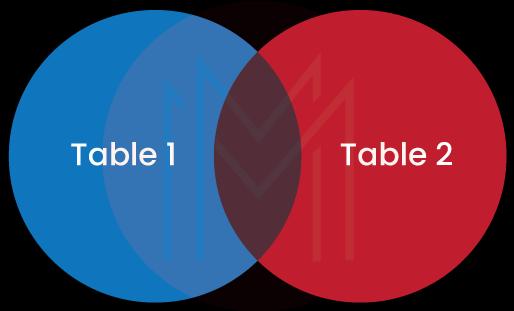
| Related Article: SQL Joins Interview Questions |
14. State the prime difference between relationship and entity.
An entity is a real-world object, whereas a relationship refers to how two entities are related to each other.
15. What is the difference between scalar functions and aggregate functions?
We apply aggregate functions across a set of values in a column. On the other hand, we use scalar functions on the given input only. The main thing is that both functions return a single value.
16. How is DBMS different from RDBMS?
| DBMS | RDBMS |
| We store data as files in DBMS | We store data as tables |
| They don’t satisfy ACID properties | They satisfy ACID properties |
| It doesn’t support normalization | It supports normalization |
| It doesn’t support distributed databases | It supports distributed databases |
17. State the differences between MySQL and SQL.
| MySQL | SQL |
| It is database software that uses SQL language | It is a query language |
| It stores data in table format | We use SQL to store, update and retrieve data |
| It supports multiple storage engines | It helps single-storage engine |
| It allows third-party processes to manipulate data. That’s why it is less secure than SQL. | It doesn't allow binaries and other processes to manipulate data during execution. |
| It doesn’t support UDFs and XML. | It supports UDFs and XML. |
18. Distinguish between clustered index and non-clustered index
| Clustered Index | Non-clustered Index |
| It focuses on the physical structure | It focuses on the logical structure |
| It is more efficient as well as flexible | It is less efficient and slower |
| It is stored along with the data | It is kept on a separate table |
| There is only one clustered index | There will be multiple non-clustered indexes |
| The index size is large | The index size is small |
19. In SQL, How to create an empty table from an existing table?
We can use the following statement to create an empty table from an existing table.

The newly created table will have the properties of the existing table, but it won't inherit triggers and indexes.
| Related Article: SQL Interview Questions |
20. Compare: TRUNCATE and DELETE statements in SQL
| TRUNCATE | DELETE |
| We use the TRUNCATE statement to remove all the records from a table | We use the DELETE statement to remove one or more records from a table based on given conditions |
| It is one of the DDL commands | It is one of the DML commands |
| It performs faster no matter the size of the databases | It serves slower when the database is large. |
| We cannot use the WHERE clause in this statement | We use the WHERE clause to remove records from a table |
| We cannot get back the truncated data again. | We can retrieve the deleted records if we need them |
Capgemini Automation Testing Interview Questions
21. What is the use of running parallel tests in Selenium?
We can run multiple modules or applications in different browsers simultaneously in parallel testing. With parallel testing, we can reduce execution time but at the same time use many resources such as devices, browsers, and the environment.
22. What do you mean by Automated Testing?
It is a testing technique with which we can perform testing automatically. We can use many tools to perform automated testing without manual intervention.
Automated testing provides high accuracy, effective resource utilization, impressive reporting, in-depth bug detection, etc.
23. Name the prime components of a Test Automation Framework.
A test automation framework consists of many prime components as follows
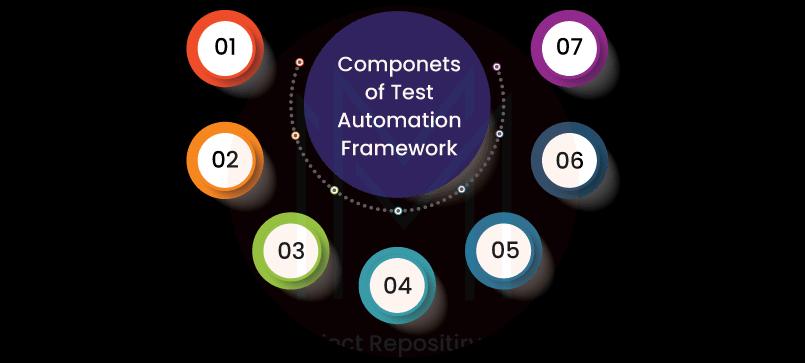
24. What do you mean by Browser Automation?
It is a process of controlling the behavior of a browser. It means that it is a process of interacting with a browser automatically.
By automating browsers, we can simplify many tasks, such as:
- Automate routine tasks
- Test websites for UI/UX flows
- Scrap data from websites
- Run performance tests
25. What do you understand by automated regression testing?
It is a type of automated testing that we perform to ensure that new updates don’t affect the normal behavior of applications. Generally, this testing is conducted multiple times to check all the components of the applications usually work. The result of this testing provides complete information about a failed test.
26. Compare automation testing with Manual Testing.
| Automation Testing | Manual Testing |
| Testers and developers perform this testing through automation tools and scripts. | Quality Analysts perform this testing manually. |
| It consumes less time and is highly efficient | It consumes more time and is less efficient. |
| Test coverage is high | Test coverage is low |
| It is reliable as well as accurate. | It is highly prone to errors |
| We can efficiently run performance testing. | We cannot run performance testing manually |
27. Under what circumstances should youn't perform automated testing?
We shouldn’t perform automated testing for the following scenarios.
- When conducting user experience tests automatically
- When running immediate tests
- We shouldn’t automate the tests that cannot be automated entirely
- When performing testing only once
- When checking the quality of a software product, it is better to use manual rather than automated testing.
28. How will you perform login automation using Selenium WebDriver?
In Selenium WebDriver, we need to perform the following steps for login automation.
- First, we need to create a Selenium web driver instance
- Then, we must configure the browser as needed
- We need to go to the required web page
- Next, we should find the relevant web content
- We need to act on the web content
- Lastly, we can verify the action
29. List the best practices that you should follow before automating tests.
Here are the best practices that we should follow before performing automated tests.
- Determining accurately what tests must be automated and what not
- It is crucial to choose the correct testing framework
- It is always better to test on real devices
- Removing unstable tests altogether
- We shall perform data-driven tests
30. How would you pick the right framework for testing?
Following are the pointers that will help to choose the right framework.
- Considering the budget constraints
- Considering the project requirements
- Analyzing and comparing different testing frameworks
Capgemini Testing Interview Questions
31. What exactly is PDCA Cycle?
PDCA refers to Plan, Do, Check, and Act. The PDCA cycle helps to improve processes by reducing mistakes. We can identify faults at the initial stages of software product development and eliminate them altogether. As a result, we can improvise processes and ability to deliver quality products.
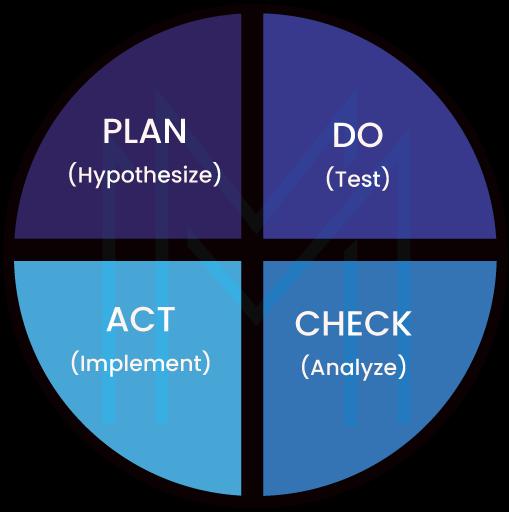
32. What do you mean by Exploratory Testing?
In this testing, we don't write testing scripts before performing tests. But we write test scripts and perform testing simultaneously. As the name suggests, we will explore new things during testing. As a result, we can create a robust test design.
33. Briefly describe Acceptance Testing.
It is the final phase of software testing. We perform this testing after the system testing and before making it available to users.
There are many types of acceptance testing, as follows
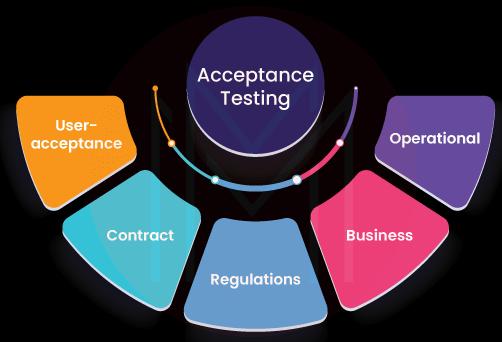
34. Briefly describe Agile Testing.
It is a software testing approach that works based on agile methodology. With agile testing, we can ensure the quality of codes developed throughout the software development process.
Through this approach, we can perform testing in every sprint continuously. There are totally five phases in every agile testing. They are listed as follows:

35. What is the use of monkey testing?
It is a software testing approach in which we randomly apply inputs into the software for testing. Mainly, we don’t build any defined test cases. By conducting monkey testing, we track the behavior of the software deeply for random inputs. Even this testing may crash the software. However, we perform this testing to find the yet-uncovered bugs.
36. How to set up the test environment for API?
We can set up the test environment for API using virtualization. In virtualization, we build a virtual copy of an API. This approach helps to reduce costs by minimizing the cost of third-party APIs and eliminating the manual efforts required for maintenance.
Furthermore, the testing environment should be easy to install, share, enhance, and tear down.
37. Differentiate verification and validation.
| Verification | Validation |
| It is done to ensure that the developed product meets the specifications set at the beginning of the development process. | The validation methods are black box testing, acceptance testing, white box testing, and so on. |
| The verification methods are code review, walkthroughs, designs, etc. | The validation methods are black box testing, acceptance testing, white box testing, and so on. |
| The testing methods are static. | The testing methods are dynamic. |
| It detects errors during the development process | It sifts through errors before launching the product into the production |
| Verification includes Quality assurance methods | Validation includes quality control methods |
38. Why do you conduct Decision Table Testing?
We conduct decision table testing on software to track the results of the software for many input combinations. In other words, the behavior of the software is tested for different combinations and recorded in a tabular form.
We conduct this testing to test software states as well. We can also analyze business rules. As a result, it helps to construct complex business logic.
39. State the difference between Dynamic Testing and Static Testing.
| Dynamic Testing | Static Testing |
| All the codes of a product are executed | Only a part of the code is executed. |
| It is performed after deploying a product. | It is performed before deploying a product. |
| This testing is costly. | This testing is cheaper. |
| It takes a long time since we execute all the codes. | It takes less time. |
| It includes boundary value analysis along with equivalence partitioning. | It includes structural as well as statement coverage testing. |
40. Which test case must we write first – black box or white box?
We must write black box test cases first. Then we must write test cases for the white black box. The project plan and design outline are necessary to write test cases for white box testing. We can get these details at the beginning of the product development.
On the other hand, we must have architecture details to write test cases for white box testing. These details will be only available in the middle of the product development. This is the reason why black box testing is performed first.
Capgemini Power BI Interview Questions
41. What is Power BI, and why do we use it?
Power BI is a business intelligence tool built with many software services, connectors, and applications. It is a tool to convert unorganized data into valuable data in different forms, such as insights, visual analytics, and reports.
This tool offers an interactive dashboard that helps to build reports and analytics as we intend. This tool provides a secure connection to data, hybrid configuration, quick deployment, etc.
| Related Article: What is Power BI? |
42. Name the vital components of Power BI.
The following are the vital components of Power BI.
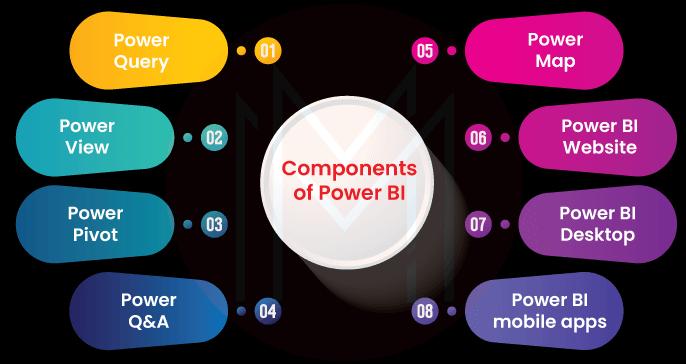
43. What exactly is bidirectional cross-filtering?
We can apply filtering on both sides of a table relationship with bidirectional cross-filtering. This method allows the development of detailed reports.
44. What is the role of Power BI Desktop?
It is an open-source application with which we can build visual analytics from the input data. Not only that, this tool allows for generating reports and uncovering insights from the data. Also, it will enable sending analytics and reports to teams and clients seamlessly.
| Related Article: Power BI Desktop Tutorial |
45. What do you mean by z-order in Power BI?
It is a process of managing the front as well as back order of visuals in a Power BI report. It allows overlapping visuals in a report. So we can place visuals over shapes.
46. Differentiate Excel and Power BI.
| Excel | Power BI |
| It allows creation of simple and less attractive reports | It will enable the creation of engaging, personalized, and interactive reports |
| It doesn’t allow advanced cross-filtering between charts | It will help advanced cross-filtering between charts |
| We cannot automate updating data | We can automate updating data |
| It has only a few data analysis capabilities | It comes with more robust data analysis capabilities |
| It is not easy to connect separate tables. | It is easy to connect separate tables. |
47. Distinguish Power BI, Power Query, and Power Pivot.
Power BI is the tool that we use to visualize data. This tool allows for building reports, analytics, etc. Once we publish a report or analytics, users can view the report on any platform – mobile, personal computer, or tablet. Besides, this tool allows the integration of R and Python languages.
Power Query is the tool that we use to import in addition to shape data. Using power query, we can fetch, change, merge, and reshape data. Also, this tool allows for setting up filters and conditions. It also helps connect with many data sources such as databases, APIs, webpages, files, cloud storage, etc. Know that M language is used in power query.
Power pivot is the tool that we use for calculations and data modeling. This tool can model complex data, set up relationships between tables, and so on. This tool allows for setting up relationships, modeling data, etc. Know that we use DAX language in power pivot.
48. How will you perform dynamic filtering in Power BI?
- First, we need to set values for the Power BI dynamic filter
- We must create a new table to store the data
- We need to label the display based on user selection
- Now, move the user selection into context with the help of the switch function
- Finally, we create a dynamic filter
49. Mention the advantages of Power BI.
- We can build interactive visuals on the dashboard
- We can frame queries in plain English language
- It provides quick and accurate analytics and reports
50. How are relationships defined in the Power BI desktop?
Relationships in Power BI are defined both manually and automatically.
Regarding manual definitions, we use primary and foreign keys to define relationships.
When it comes to automatic, the relationships between tables are defined automatically.
Capgemini Leadership Principles

At Capgemini, they don't just work, they live and breathe these leadership principles. Honesty is the foundation of all their relationships, and they boldly face challenges head-on. Their trust in their colleagues' expertise empowers them with the freedom to innovate. But it's not all work and no play – Capgemini value fun and celebrate their successes with modesty. Most importantly, they foster a culture of team spirit, where collaboration and support are key. These principles define Capgemini's environment and spirit, and they strive to uphold them every day in everything they do.
Tips to Crack Capgemini Interview
Follow these tips to crack your Capgemini interview
- Before you go to your Capgemini interview, make sure you know as much as possible about the company. Look up their history, mission, values, and recent projects they've worked on. This will help you understand the company culture and prepare you for potential questions.
- Take some time to review the job description for the position you're applying for. Identify the key skills and requirements and make sure you have examples of how you meet those criteria.
- Consider the questions you may be asked during the interview and practice your answers. This will help you feel more confident and prepared.
- During the Capgemini interview, you'll likely be asked about your previous work experience. Be prepared to talk about your accomplishments and provide examples of how you've succeeded in previous roles.
- It's important to make a good impression during your Capgemini interview. Dress appropriately for the job you're applying for and make sure your outfit is clean and ironed.
- Arrive at least 10-15 minutes early to allow yourself time to check in and get settled before the interview begins.
- Bring several copies of your resume to the interview in case multiple people will be interviewing you.
- At the end of the interview, you'll likely be given the opportunity to ask questions. Prepare a few questions ahead of time to show your interest in the position and the company.
- Send a thank you email or note to your interviewer after the Capgemini interview to express your appreciation and reiterate your interest in the position.
- It's important to stay positive throughout the Capgemini interview process. Even if you don't get the job, you can learn from the experience and use it to prepare for future interviews.
Most Commonly Asked Capgemini FAQ
1. Is the Capgemini interview tough?
The chances of the Capgemini interview being tough depends on the preparation level of the candidate. You are required to showcase your expertise. It is also suggested to focus on technical and coded related questions along with preparing for aptitude.
2. Why should we hire you to answer for Capgemini?
Capgemini will give me a platform to showcase my technical skills while learning and being better at my job. With my solid skillset and intent, I would look forward in being significant in the upliftment of your company.
3. What type of questions are asked in the Capgemini interview?
There are different types of questions asked in the Capgemini interview. An online assessment is given to the shortlisted applicants. It is divided into four parts – coding test, communication test, aptitude test, behavioral and personality-related test.
4. How many rounds of interviews are there in Capgemini?
There will be three rounds. The first round will be based on your aptitude. The second one will be purely technical where questions related to your knowledge of the basics will be asked. In the case of experienced candidates, past work-related questions will be asked. The third and final round will be the HR round.
5. Is the Capgemini interview tough for freshers?
Yes. Despite Capgemini being the leading entity for recruiting freshers, it might be quite difficult to crack the interview.
Conclusion
If you're preparing for an interview at Capgemini, you're not alone. With so many talented individuals vying for positions, it's important to set yourself apart by being well-prepared and confident. By mastering the top Capgemini interview questions and showcasing your skills and experience, you'll be well on your way to securing a position in this exciting and dynamic industry. With a commitment to excellence and a willingness to learn and grow, the possibilities are endless. According to a recent survey, the IT industry is expected to grow exponentially in the coming years, with an estimated job growth rate of 11% in the next decade. Learning the Capgemini interview questions and preparing for them will not only help you secure a job but also put you on the path to leading the industry in the future. If you want to prepare further, you can successfully attend MindMajix courses and ace your Capgemini Interview.
"If you wish to learn about Python, you may enroll in a Python Course and achieve certification."
 On-Job Support Service
On-Job Support Service
Online Work Support for your on-job roles.

Our work-support plans provide precise options as per your project tasks. Whether you are a newbie or an experienced professional seeking assistance in completing project tasks, we are here with the following plans to meet your custom needs:
- Pay Per Hour
- Pay Per Week
- Monthly
| Name | Dates | |
|---|---|---|
| Python Training | Dec 16 to Dec 31 | View Details |
| Python Training | Dec 20 to Jan 04 | View Details |
| Python Training | Dec 23 to Jan 07 | View Details |
| Python Training | Dec 27 to Jan 11 | View Details |

Madhuri is a Senior Content Creator at MindMajix. She has written about a range of different topics on various technologies, which include, Splunk, Tensorflow, Selenium, and CEH. She spends most of her time researching on technology, and startups. Connect with her via LinkedIn and Twitter .
















